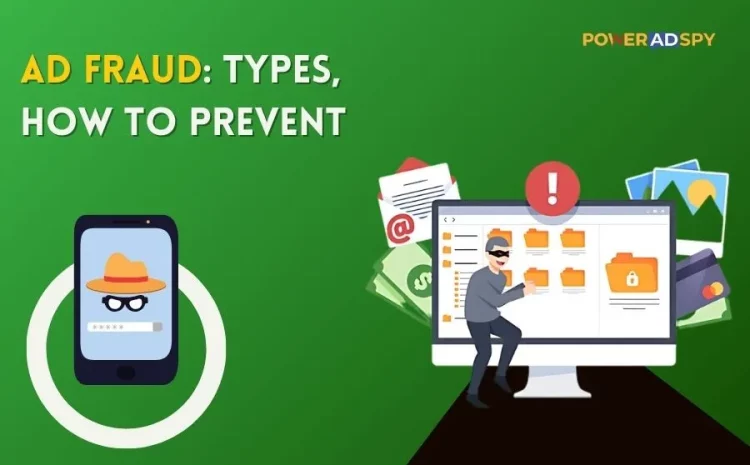Ad Fraud: Types, How To Prevent
Ad fraud has cost the industry a jaw-dropping $100 billion by 2023. This alarming figure marks a dramatic increase from the $35 billion lost in 2018, reflecting an exponential growth that poses a significant threat to advertisers worldwide. As digital marketing grows, fraudulent activities become more sophisticated and common. It makes it crucial for marketers to understand and fight ad fraud effectively.
In this blog, we will discuss fraudulent ads, how they affect digital marketing ROI, and the best ways to protect your campaigns. Whether you are an experienced marketer or just starting, understanding ad fraud and using effective protection strategies can significantly improve your advertising success.
Listen To The Podcast Now!
What Is Ad Fraud?
Ad fraud refers to any deliberate activity that prevents the proper delivery of ads to the intended audience. It can involve generating fake impressions, clicks, conversions, or other engagement metrics. The main objective of such fraud is to divert advertising funds from legitimate ad placements to fraudulent entities.
When clicks go up, the advertiser earns more, and the publisher gets paid. This fraud can be carried out by competitors or dishonest publishers using automated bots to click on ads.
Now that you understand fraudulent ads, let us dive into the different types and how they operate.
Types of Ad Fraud
Ad fraud takes many forms, each employing distinct methods and influencing advertising campaigns differently. Below are several prevalent types:
1. Click Fraud:
This fraud entails creating artificial clicks on pay-per-click (PPC) ads. Perpetrators employ automated bots or enlist individuals to click on ads repeatedly. The following are some commonly used methods.
Methods Used:
- Automated Bots: Fraudsters use advanced bots to mimic human behavior, rapidly clicking on ads from various IP addresses and devices, making detection difficult.
- Manual Click Farms: Manual click farms involve hiring individuals to click on ads repeatedly using multiple accounts or devices, aiming to evade detection.
2. Impression Fraud:
Fake impressions are generated to manipulate metrics in display advertising. It often involves bots that load ads without human viewers. Here is how it typically happens:
- Bots and Automated Scripts: Fraudsters deploy automated bots or scripts that simulate human browsing behavior. These bots visit web pages where ads are displayed, causing the ad server to count ad impressions as if they were legitimate views by actual users.
- Hidden or Stacked Ads: These ads are hidden or stacked on a webpage, making them invisible to users but still counted as impressions by the ad server.
- Ad Injection: Malware installed on users’ devices injects ads into web pages without the user’s knowledge. These injected ads generate impressions without any human interaction.
- Traffic Exchange Networks: Some networks promise to deliver traffic and impressions at low costs. However, the quality of this traffic is often doubtful, with many impressions coming from automated sources rather than genuine users.
3. Conversion Fraud:
Conversion fraud is when someone tricks a system into thinking they’ve completed a desired action, like clicking an ad or making a purchase, but they haven’t done it. This deception can happen through automated programs, fake accounts, or other dishonest methods, aiming to profit unfairly from online activities.
Here is how it typically happens:
- Fake Form Submissions: Fraudsters use bots to fill out lead generation forms, creating fake leads without real customer interest.
- Fake Purchases: Bots can be programmed to simulate purchases on e-commerce platforms, mimicking real transactions without exchanging any actual products or services.
- Cookie Stuffing: This technique involves placing fraudulent cookies on users’ devices without their knowledge. When these users later make a legitimate purchase or sign up for a service, the fraudster falsely claims credit for the conversion.
- Collusion with Affiliates: In affiliate marketing, fraudsters, and affiliates may coordinate to generate fake conversions using misleading tactics, earning commissions from fraudulent leads or sales.
- Adaptive Fraud: Advanced fraudsters continually adapt their tactics to evade their ad fraud detection. They may change IP addresses, user agents, or other identifying information to appear as legitimate traffic.
4. Ad Stacking:
Ad stacking is a deceptive digital advertising practice where multiple ads get layered within a single ad placement on a webpage or mobile app. Here is how it typically happens:
- Layering Ads: Fraudsters place several ads within the same ad placement space. These ads are stacked one on top of another, often hidden from view except for the topmost ad.
- Deceptive Metrics: Advertisers get misled to believe their ads have multiple impressions, boosting perceived reach and engagement, though these impressions are not seen or interacted with by real users.
- Revenue Skimming: By stacking multiple ads, fraudsters can earn revenue from advertisers based on inflated impression metrics, diverting advertising spending away from legitimate publishers and advertisers.
5. Pixel stuffing
Pixel stuffing is a technique where tiny, invisible ads are placed on web pages. Though unseen by users, these ads are counted as viewed impressions, exploiting web page rendering technology.
Here is how pixel stuffing typically works:
- Invisible Placement: Fraudsters place pixel-sized ads in webpage code designed to blend into the background or remain unseen on the screen.
- Counted Impressions: When someone loads the webpage, their browser displays all elements, including pixel-sized ads. Ad servers then record each impression of these ads, counting them as viewed by the visitor.
- Fraudulent Metrics: Pixel stuffing deceives advertisers by artificially inflating impression counts, creating misleading performance metrics, and wasting advertising budgets.
- Automated Processes: Pixel stuffing uses automatic scripts or bots to generate large volumes of tiny ad placements across multiple websites, enabling fraudsters to scale their operations and maximize their gains.
We have learned a lot about the various types of ad fraud, and now let us understand how it can affect your ROI.
How Ad Fraud Affects ROI In Digital Marketing
Advertising fraud significantly distorts the true performance of digital marketing campaigns, leading to misguided decisions and wasted budgets. Here is how it impacts ROI:
1. Budget Drain: Ad fraud redirects advertising funds to fake engagements, failing to deliver real value or reach intended audiences. This means that a significant portion of your marketing budget is wasted on fraudulent activities, rather than being spent on reaching potential customers who could convert.
2. Misleading Metrics: Fraudulent activities inflate engagement metrics like clicks, impressions, and interactions, misleading marketers and complicating accurate strategy assessment. This can mislead marketers into believing their strategies are effective, complicating the process of accurately assessing and optimizing marketing efforts. The false data can lead to misguided decisions, further wasting resources and time.
3. Tarnished Brand Reputation: Websites spreading misinformation often use mainstream ads to seem credible. Many large brands use automated platforms for advertising, losing control over ad placement. This can lead to brand ads appearing next to fraudulent content, conflicting with the brand’s values. This can badly affect your brand reputation.
4. Lower Conversion Rates: When ads are shown to bots or disinterested viewers instead of genuine, interested potential customers, the likelihood of achieving meaningful actions such as conversions or purchases decreases. This results in lower conversion rates, as the ads are not reaching the right audience.
ROI is the key metric in digital marketing. As a Facebook marketer, optimizing your budget is crucial. To avoid wasting resources, regularly review Facebook ad policies for the latest updates and guidelines.
Fraudulent ads can drastically harm ROI and distort insights. It is essential to detect and prevent these practices. Let us explore how to identify and protect your marketing investments from fraud.
Identifying Ad Fraud In Social Media Campaigns
Social media platforms are vulnerable to fraud. Identifying and mitigating fraudulent activities is crucial to protect your campaigns. Here are signs of advertising fraud in social media campaigns:
Unusual Traffic Patterns: Sudden spikes in traffic that do not align with your campaign strategy or historical data could indicate fraudulent activities, such as bot traffic artificially inflating impressions.
Low Engagement Rates: High impressions or clicks with few likes, shares, comments, or conversions may indicate fraudulent behavior, whereas bots or disinterested users generate superficial engagement.
Bot-like Behavior: Engagement from accounts with repetitive IP addresses, incomplete profiles, or no genuine followers suggests automated bot activity rather than genuine human interaction.
Click Farms: Be wary of unusually high click volumes originating from regions known for click farms. These operations involve networks of individuals or automated systems clicking on ads multiple times, thereby distorting engagement metrics.
We have discussed the impact and how to identify fraud. Next, we will explore strategies to prevent and protect against ad fraud.
Also Read
What Is An Ad Impression And Why Is It Important?
Facebook Ad Policy: 16 Things You Should Avoid At Any Cost
Ad Fraud Protection Strategies
Protecting your digital marketing campaigns from advertising fraud necessitates a comprehensive approach that integrates various strategies:
Traffic Quality Analysis
Regularly assess the quality of your traffic using tools like Google Analytics. Look for unusual spikes in traffic that do not correlate with your campaign efforts, as these could indicate bot-generated visits or click farms. Analyzing traffic sources helps you identify and block low-quality sources that contribute to advertising fraud.
IP Blocking
Employ IP blocking techniques to restrict access from IP addresses associated with fraudulent activities. Many advertising platforms offer IP-blocking functionalities that allow you to blacklist suspicious IPs, reducing the risk of bot-driven ad interactions and preserving your ad budget for genuine audience engagement. It can also prevent click fraud.
Third-Party Verification
Utilize third-party verification services to independently audit your ad campaigns. These services employ rigorous validation methods and proprietary algorithms to verify the legitimacy of ad impressions and clicks. You can ensure transparency and accountability in your digital advertising efforts by partnering with trusted verification providers.
Use of ads.txt Files and sellers.json
Implementing ads.txt files and ensuring valid sellers.json files for your partners helps verify authorized inventory resellers. This transparency prevents unauthorized entities from selling ad space on your behalf, reducing the risk of fraudulent ad placements.
Collecting Data From End-User Devices
Using client-side signals such as touch events, typing speed, and sensor signals helps detect mobile ad fraud techniques like SDK spoofing. Analyzing these signals provides insights into whether interactions originate from genuine human behavior or automated scripts.
Reviewing Signature Signals
Monitoring HTTP, TLS, browser, and mobile fingerprints enables the identification of fraudulent activities by comparing signatures associated with legitimate user interactions. This method enhances detection capabilities, ensuring engagements align with authentic user behaviors.
User Testing
Engaging users to test your website and provide feedback on their ad experiences helps identify issues like ad injections or forced redirects. This firsthand feedback improves the detection of malicious ad practices that could compromise user experience and trust.
Staying Informed
Keeping abreast of industry research and trends in ad fraud helps stay ahead of evolving tactics employed by fraudsters. This knowledge enables proactive adjustments to your defense strategies, ensuring ongoing protection against emerging threats.
Blocking Risky IP Addresses
Identifying and blocking IP addresses associated with suspicious activities from accessing your website prevents fraudulent engagements and protects your digital assets from malicious intent.
Utilizing Bot Management Systems
Implementing AI and ML-powered bot management systems helps differentiate between human and bot traffic. This proactive defense mechanism automates the detection and mitigation of malicious bots, preserving the integrity of your ad campaigns and user interactions.
Using Anti-Malvertising Software
Deploying anti-malvertising software and plugins enhances real-time detection of malicious code embedded in digital ads. This software immediately protects against malware-driven threats such as forced redirects, safeguarding user security and experience.
Include Captcha
Incorporating CAPTCHA into ad interactions is a valuable strategy for preventing click fraud, safeguarding ad campaigns, and ensuring genuine engagement and ROI. CAPTCHA challenges are designed to differentiate between human users and automated bots. By requiring users to solve these challenges before interacting with ads, CAPTCHA verifies the presence of genuine human engagement, reducing the likelihood of fraudulent bot clicks.
If you’re seeking an ad intelligence tool to monitor ad trends, we have the perfect solution.
Poweradspy – Advanced Ad Intelligence Tool
PowerAdSpy is an advanced ad intelligence tool that enables you to monitor competitors and perform in-depth competitive analysis. This powerful tool supports your digital marketing campaigns and helps you identify ad trends. PowerAdSpy offers robust features that can effectively aid in preventing ad fraud:
- Full Transparency: PowerAdSpy offers a comprehensive insight into ad analytics through direct access to live ad posts. This transparency empowers you to monitor real-time engagement and audience feedback, ensuring ads align with authentic user interactions.
- Millions of Ads Across 100+ Countries: With a vast database of millions of ads from over 100 countries, PowerAdSpy empowers you to stay updated on the latest successful ad campaigns. This extensive data helps monitor trends and benchmarks, necessary for distinguishing legitimate ads from fraudulent ones.
- Narrow Searches by Niche and Competitors: The ability to search ads by niche keywords, advertisers, and competitor domains allows you to deeply analyze competitors’ ad strategies.
- Engagement-Oriented Insights: PowerAdSpy delivers detailed engagement metrics for social ads, facilitating the identification of high-performing campaigns within your niche.
- Video and Image Ad Analysis: By analyzing both video and image ad categories, PowerAdSpy provides insights into which formats resonate best with your target audience. This knowledge aids in crafting effective ad strategies.
- GEO-Targeting Analysis: Leveraging its extensive ad data, PowerAdSpy offers precise GEO-targeting insights. This feature assists in identifying legitimate audience segments interested in your products or services.
Conclusion
Ad fraud poses a significant threat to digital marketing, costing the industry $100 billion by 2023. Ad fraud not only drains budgets and distorts performance metrics but also erodes trust and reduces conversion rates.
To mitigate these risks, it’s essential to implement strong strategies. Techniques such as IP blocking, third-party verification, and using ads.txt files enhance transparency and protect against unauthorized ad placements. Monitoring traffic quality, employing bot management systems, and leveraging tools like PowerAdSpy for competitive analysis can help you identify organic engagement.
FAQ
How to protect from ad fraud?
Protecting from ad fraud involves using ad intelligence tools, implementing strict traffic quality analysis, employing IP blocking, leveraging third-party verification services, and staying informed about industry trends.
How to identify ad fraud?
To identify ad fraud, monitor for unusual traffic patterns, low engagement rates relative to high impressions or clicks, and bot-like behavior such as repetitive IP addresses or incomplete profiles.
How do ad fraud scammers make money?
Scammers employ various tactics to simulate real user activity on advertising platforms. By creating the illusion of genuine engagement, these fraudsters deceive advertising networks into rewarding them financially for what appears to be legitimate traffic and interaction.
How common is ad fraud?
Juniper’s study analyzed digital advertising in 45 countries across 8 regions, using a dataset of over 78,700 data points from 2019 to 2028. The research found that 22% of all online ad spending was lost due to ad fraud in 2023.










